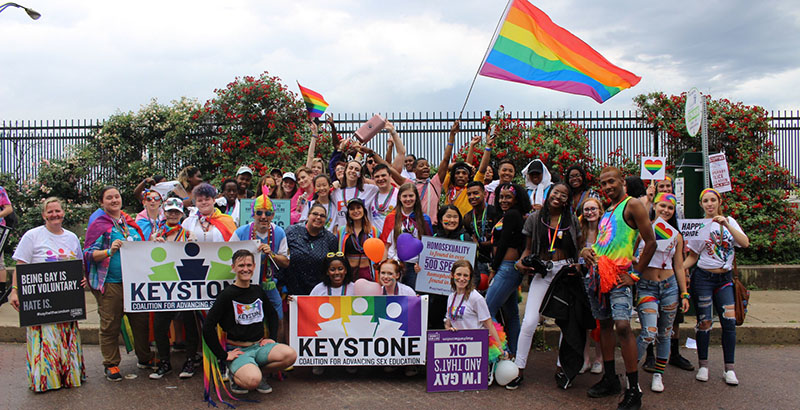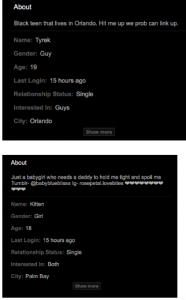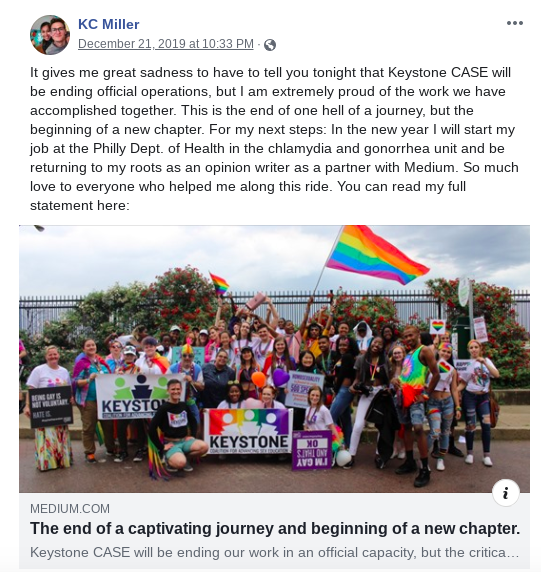How a Lack of Inclusive Sex Education and a Reliance on Pornography Leave LGBTQ Youth Facing Greater Risks Than Their Straight Peers

“Gay kids are receiving their education the way everybody gets their sex education, and unfortunately, that’s by watching porn,” said Bronwen Pardes, a sex educator and author of Doing It Right: Making Smart, Safe, and Satisfying Choices About Sex.
The results for LGBTQ youth can be even more catastrophic than for their straight peers. A 2015 study by the Centers for Disease Control focused on lesbian, gay and bisexual-identifying teens reported that young gay and bisexual males have disproportionately high rates of HIV, syphilis and other sexually transmitted diseases (STDs), and adolescent lesbian and bisexual females are more likely to have gotten pregnant than their heterosexual peers.
KC Miller, an openly gay teen and recent graduate of Westtown School in West Chester, Pennsylvania, recounts his early sex-ed experience. “For middle school, I attended Twin Valley School District. Our ‘Introduction to Puberty’ classes were both noninclusive and, in the early stages, they were segregated. The lessons were heteronormative and abstinence-based.” Miller also acknowledges Pardes’s point of porn being the main tool for sex ed among his peers, both heterosexual and LGBTQ-identifying:
“Students from all walks of life are resorting to pornography and other sexually explicit materials when their classrooms fail them,” Miller, who advocates for inclusive sex ed, told The 74. “It is a disaster because porn rarely offers accurate portrayals of a healthy sexual experience. Not to mention, the porn industry is entrenched in racism and misogyny. Students need to understand that pornography is a fantasy, and that the best sex starts with communication between your partners.”
The Human Rights Campaign’s 2015 joint report with Rutgers University points to the lack of sex education as having an adverse impact on the health of LGBTQ youth and cites the same CDC study that shows that most new HIV infections among youth ages 13-24 occur among gay and bisexual men and transgender women who have sex with men.
Besides the increased risk of contracting sexually transmitted infections, gay males in particular face potential physical harm as a result of their use of pornography as a road map for how to engage in anal sex.
“The people that are performing it [in gay male pornography] are very experienced with it,” said Theodora Sirota, chair of the University of St. Joseph Department of Nursing in West Hartford, Connecticut. “And they go after actors that are very well-endowed, and so kids can get the wrong idea. You can literally get ripped to death with some of this stuff — it’s dangerous if no one gives you instruction.”
Sirota has conducted research on the developmental stages of LGBTQ youth and has worked extensively with trans women and people who struggle with their sexual orientation.
Only 10 states require that sex ed discuss sexual orientation
Even the most basic sex education is not universally taught across the U.S. According to the Guttmacher Institute, 27 states and D.C. mandate both sex education and HIV education. The remaining states require some form of sex education, but what’s taught ranges from a comprehensive sex education curriculum to basic contraception instruction — e.g., how to use a condom. Only 17 states require that sex-ed curriculum be medically accurate, according to Guttmacher.
Only 10 states — California, Colorado, Delaware, Iowa, New Jersey, New Mexico, Oregon, Rhode Island and Washington state, along with D.C. — require a discussion of sexual orientation. In Arizona, if or when HIV education is taught, teachers cannot “promote” a “homosexual lifestyle” or portray homosexuality in a positive manner.
For Dr. Charles Silverstein, the conversation around the lack of sex education for LGBTQ youth is an old story. The clinical psychologist and sex therapist is also a co-author of the popular self-help guide The Joy of Gay Sex, which was first published in 1977 and is now on its third revised and updated edition.
“We wrote the kind of book we would have wanted when we were kids,” he said.
Silverstein counsels gay people of all ages and recalls trying to advise one of his teen clients about his risky sexual behavior. “I was working with an 18- or 19-year-old — he was very sexually active. He didn’t use condoms, nor was he on PrEP. That’s an HIV contagion waiting to happen,” Silverstein said.
PrEP (Pre-exposure prophylaxis) is a drug generally marketed to gay men that, if taken once daily, is cited for lowering the chances of HIV infection by 90 percent.
Teens taking in porn’s unrealistic depictions of sex
Young LGBTQ people, like all young people, often turn to porn for their sex education, and given the size of the highly lucrative industry, they have many options to choose from.
The most frequently visited site is Pornhub, which clocked 81 million visitors a day in 2017 — 50,000 searches per minute, 800 searches per second. The U.S. leads all countries with the highest traffic on the site. According to Pornhub’s 2017 Pride Insights, its in-house analysis of its LGBT content traffic, of the 4.4 million U.S. daily visitors to Pornhub’s “gay hub,” around 272,800 are 18-to-24-year-olds.
Teens are definitely on these sites in great numbers and are taking in a lot of the unrealistic depictions of sex on the site as mentioned by Sirota. Since you have to be at least 18 to engage on the site, sometimes teens may say they’re older than they really are in order to take part in the hook-up aspect of sites like Pornhub:
The three searches that dominate among gay male visitors to Pornhub are “black,” “straight” and “bareback.”
“I think seeing it raw [sex without a condom] like that gives kids the wrong impression,” said Sirota. “They’re not seeing reality. They just see it and they figure this is how it’s supposed to be.”
For women, the category of “lesbian” is the most-watched content on Pornhub. Coming in second place for women is gay male porn. Women make up 26 percent of all visitors to Pornhub but 37 percent of the visitors viewing gay male porn, according to the site. So a lot of queer women and women in general are also turning to porn for depictions of sex.
Pornhub launches ‘Sexual Wellness’ site
To help offset some of the unrealistic images proliferating online, Pornhub is actually one site that uses its platform and audience to deliver sex education. Its “Sexual Wellness” site is overseen by Dr. Laurie Betito, a licensed clinical psychologist and author who specializes in sex therapy.
“My motivation was to reach as many people as I could with sex-positive messages and good sexual-health information,” said Betito, a well-known syndicated radio host in Canada. “Pornhub was looking for a community project, so we got together and did this.”
The site launched in early 2017 and has content that ranges from reproductive health to whether or not a person should share with their partner that they still enjoy watching porn from time to time. The site also includes articles that address issues specific to the LGBTQ community, such as sex for lesbians and gender expression. Betito oversees the Q&A section of the website, where she often fields questions related to sexual identity.
“I don’t have ages, but I can probably guess their age by their questions,” she said. “I have people questioning their orientation. ‘If I have a same-sex fantasy, does that make me gay?’ ‘If I want to experiment with the same sex, does that make me gay?’ Questions like that where I can tell they have very limited information.”
Still, in comparison to Pornhub’s 81 million daily visitors, its “Sexual Wellness” site sees relatively few visits — only 4 million hits in all of 2017.
There are several teens across the country taking steps of their own to effect change when it comes to sex education for LGBTQ youth. Miller, the Pennsylvania teen, was recently featured in a TED Talk for his efforts in trying to make sex education more inclusive. He also started an organization called The Keystone Coalition for Advancing Sex Education, which serves as the vehicle for his message.
“Keystone CASE’s ultimate goal is to pass legislation that will improve standards and advance sex education to be comprehensive and inclusive,” Miller said. “Through my organization I’ve written a state bill titled the “Pennsylvania Healthy Youth Act,” which is influenced by a successful bill called the “California Healthy Youth Act” and a failed earlier attempt in the Pennsylvania legislature,” Miller said.
The bill was referred to the health subcommittee in the Pennsylvania General Assembly in August 2017, the last time action was taken on the measure.
Just recently, Miller announced on Facebook the end of the official operation of The Keystone Coalition, but he plans on continuing the pursuit of advocating for appropriate sex education for all.
Miller is just getting started and hopes to change what sex education classes can look like, not only in Pennsylvania but also across the country.
“In my eyes, comprehensive sex education is a human right,” he said. “People deserve access to medically accurate, unbiased information about how to keep their bodies safe, happy and healthy. In the United States, we are failing to provide this basic human right. Instead of empowering students with knowledge, we feed them fear and encourage them to bury away sexuality.”
The lack of sex education that’s inclusive of sexual orientation comes as no surprise to Brownen Pardes, the sex educator and author: “If there is good sex ed going on — and oftentimes there isn’t — it mostly assumes that you’re straight, and if you’re really lucky there’s a little conversation on being gay.”
Silverstein, the co-author of The Joy of Gay Sex, understands all too well how much resistance there is to providing honest, straightforward information on sex for gay people. Silverstein explained how his book was banned in Canada in the late 1980s because its descriptions and illustrations of anal sex were deemed “obscene” by the Canadian customs service. In a subsequent trial, Judge Bruce Hawkins overturned the ban.
6/1. THE JOY OF GAY SEX, Dr Charles Silverstein & Edmund White (1977)
“Written by homosexuals for homosexuals” said one blurb, this was an LGBT version of a popular 1970’s book, The Joy of Sex. For someone coming out, trying to make sense of it all, this was a great resource. pic.twitter.com/ev6Q0oJ8Ql— Douglas Hardy ?️? (@douglashardy) June 1, 2019
Silverstein, who testified in the case, still remembers what Hawkins said in his ruling: “He said that writing a book about gay sex and omitting anal intercourse would be like writing a history of music and omitting Mozart.”
This article was provided to The 74 through StorySquare, a platform connecting freelancers with media outlets.
Help fund stories like this. Donate now!

;)

